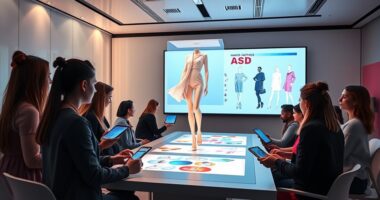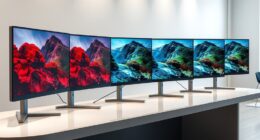Moving from retail sales to visual merchandising lets you use your customer interaction skills and creative flair in a more strategic role. You’ll shift from direct selling to designing store layouts, displays, and environments that attract shoppers and boost sales. Your understanding of shopper behavior helps craft visual stories that engage customers emotionally. With this move, you’ll create immersive, appealing spaces that encourage exploration. To discover how to make this change smoothly, keep exploring these ideas.
Key Takeaways
- Leverage your customer interaction skills to understand shopper behavior and inform visual display strategies.
- Gain knowledge of store layout, signage, lighting, and product placement to create engaging environments.
- Develop an eye for aesthetics and storytelling to craft compelling visual narratives that attract customers.
- Collaborate with sales associates to ensure store layouts guide customer flow and enhance shopping experiences.
- Pursue specialized training or certifications in visual merchandising to build relevant skills and industry knowledge.

Moving from retail sales to visual merchandising offers an exciting opportunity to leverage your customer interaction skills in a more creative and strategic role. Your experience talking to customers gives you a solid foundation for understanding what draws their attention and how they navigate a store. Now, you get to channel that knowledge into designing store layouts that not only look appealing but also guide customers effortlessly through the space. Visual merchandising isn’t just about making displays look good; it’s about creating an environment that encourages exploration and boosts sales. Your ability to connect with customers helps you grasp what they’re seeking, which you can translate into compelling visual stories that resonate with your target audience.
Transitioning from retail sales to visual merchandising lets you craft engaging, strategic store environments that attract and inspire customers.
In this new role, your focus shifts from direct sales to orchestrating the overall store experience. You’ll think about the store layout in a strategic way—where to position high-margin products, how to create focal points, and how to ensure the flow encourages customers to spend more time. You’ll consider eye-level displays, signage, lighting, and even the placement of fixtures to optimize customer engagement. When designing a layout, you’ll aim to make shopping intuitive and enjoyable, reducing frustration and making it easier for customers to find what they need. This process involves analyzing foot traffic patterns and adjusting store elements to maximize exposure for key merchandise. Developing an understanding of visual storytelling helps you craft immersive environments that attract and retain shoppers.
Your customer engagement skills become invaluable here because understanding shopper behaviors allows you to craft visual narratives that appeal on an emotional level. You’ll learn to anticipate what catches the eye and what prompts a purchase, using your insights to create displays that tell a story or evoke an aspirational lifestyle. Effective visual merchandising turns passive window shoppers into active participants by encouraging them to explore different sections of the store. You’ll also collaborate with sales associates, helping them understand how the store layout influences customer movement and behavior. This teamwork ensures that everyone is aligned in delivering a seamless shopping experience.
Transitioning into visual merchandising means you’ll need to develop an eye for aesthetics and a strategic mindset. Your ability to analyze consumer preferences and translate that into visually compelling setups will set you apart. It’s about more than decorating; it’s about shaping the entire shopping environment to boost customer engagement and increase sales. With your retail sales background, you already know what customers want, and now you get to design the space that makes it irresistible for them to stay longer, browse more, and ultimately, make more purchases.
Frequently Asked Questions
What Skills Are Essential for a Successful Shift to Visual Merchandising?
To succeed in visual merchandising, you need strong retail insight and a knack for customer engagement. Your ability to understand what attracts customers and how they interact with displays helps craft compelling visual stories. You should be creative, detail-oriented, and able to coordinate colors and themes effectively. Plus, your skills in analyzing trends and adjusting displays keep shoppers interested and boost sales, making you a valuable asset in any retail environment.
How Can Retail Sales Experience Benefit a Career in Visual Merchandising?
You might think retail sales experience doesn’t directly translate to visual merchandising, but it’s essential. Your understanding of customer engagement helps you craft displays that attract and inspire shoppers. Plus, your product presentation skills ensure merchandise looks appealing. This background gives you a strong foundation to create compelling visual stories, enhancing sales and customer satisfaction. Your retail know-how seamlessly supports your move into visual merchandising, making your shift smoother and more effective.
What Certifications or Training Programs Are Recommended for Visual Merchandisers?
You should consider certifications in fashion design or brand management, as they enhance your visual storytelling skills. Look for programs from reputable institutions or online platforms that focus on retail display, color theory, and aesthetics. Practical workshops or courses in visual merchandising can also boost your confidence. These certifications help you create compelling displays, understand brand identity, and stand out in the competitive visual merchandising field.
How Do I Build a Professional Portfolio in Visual Merchandising?
Imagine your work as a vivid storybook, each page showcasing your visual storytelling skills. To build a professional portfolio, select diverse projects that highlight your creativity and understanding of brand consistency. Include before-and-after images, sketches, and mood boards. Show your process from concept to execution, demonstrating your ability to craft compelling displays. Keep it organized, polished, and tailored to the types of brands or environments you aspire to work with.
What Are Common Challenges Faced When Transitioning Careers Into Visual Merchandising?
You’ll face challenges like adapting to retail industry dynamics and mastering customer behavior analysis. Moving into visual merchandising requires understanding how visual elements influence shoppers and staying current with trends. You might struggle with translating sales skills into creative displays or gaining experience without a background in design. But, by learning retail trends, observing customer reactions, and gaining hands-on experience, you can overcome these hurdles and succeed in your new role.
Conclusion
As you shift from retail sales to visual merchandising, remember that your new role is a canvas waiting for your creativity. Every display you craft is a story, a silent salesperson whispering to customers. Embrace this change; it’s not just a job, but an opportunity to transform spaces and influence purchasing decisions. Like a painter with a brush, your vision can turn everyday products into irresistible attractions—because in this world, your creativity is the key to enthralling hearts and minds.










